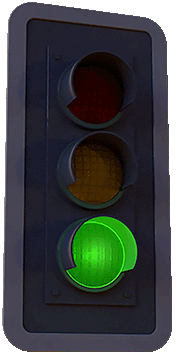
When my godson was around 8 years old I told him the following joke, which he then ran around repeating to anyone who would listen:
Some aliens landed on Earth to study humans. When they returned to their home planet, they told everyone about their visit. They were most impressed by traffic lights. They said, "We think green means go, yellow means go faster, and red means stop and pick your nose."
That was before cell phones. These days stop lights afford us the opportunity to send a text or look for a song on Spotify. But I've taken to heart George Carlin's advice about traffic lights: "drive a little while, rest a little while." Sure, red lights promote safety, but most people, it seems, think of red lights as something that gets in the way, slows down your progress, keeps you from getting to your destination on time. There's another way to look at them: they are opportunities to take a time out and let go of some of the stress you've accumulated from driving in traffic. So why not take the 30 or 40 seconds or so of free time the traffic authorities have given you to do one of these exercises? You might get so into it you won’t notice when the light turns green. But don't worry. The kind person in the car behind you will let you know.

Inhale. Many people, especially when stressed, breathe only in the upper chest. The diaphragm, which contracts and allows air to be sucked into the lungs, doesn't descend fully, so oxygen doesn't reach the lower parts of the lungs and the diaphragm doesn't adequately stabilize the low back. Yes, the diaphragm is a key muscle in core stabilization. So an easy and very helpful red light exercise is to relax the belly and allow—not force—the inhalation to expand the lower ribs. This helps to relax tension in the neck and shoulders.

Exhale. Duh! No, really. Exhalation is performed by the transverse abdominal muscles (TrA), another key core stabilizer. These muscles wrap around the abdomen from the back of the rib cage to the front of the body. They're tucked under that muscular six pack some people sweat so hard to attain. They are a key component of the muscular back brace that supports our middles. All that is required to exercise these muscles is to exhale through pursed lips. Blowing out through the resistance of the lips causes the TrA to work a little harder. This exercise can be combined with the first one.

Neck range of motion. You've probably been staring at your windshield since you got into your car. Why keep looking straight ahead now that you don't have to? But wait! Don't roll your head around (and don't crack your neck). That will only make the muscles in your neck tighten up more. Instead, isolate your ranges of motion. First, look down and then up. Next, turn your head to look over one shoulder, then the other. Finally, tilt your head like you're bringing your ear toward your shoulder, then go the other way. Try not to go too fast; think of the pendulum of a clock. The point of this exercise is not to stretch muscles; rather, moving through these cardinal directions helps to coordinate the sensation of joint position and movement—proprioception—with the contraction and relaxation of muscles controlled by the central nervous system. So don't force each motion, just move your head and neck as far as you comfortably can, trusting that over time you will improve your range of motion and perhaps work out the kinks in you neck.


Chin tuck. This is another motion your neck is capable of. The technical word is translation.
Chin tuck causes forward and back gliding of vertebrae on each other. It can help to restore the normal forward curve of the neck in individuals who have developed straight or military necks. Its more immediate benefit is to relax the muscles that connect the base of the skull with the top two cervical (neck) vertebrae which, when too tight, can cause a tension-type headache. To learn how to do this, get a ball about the size of your head or slightly smaller, stand facing a wall, and put the ball between your forehead and the wall. Now look down, rolling the ball as you do so. Try not to push your head into the ball. Instead, you should create a reciprocal movement between the ball and your head. You are literally rolling your head on top of your neck, just as the ball is rolling on the wall in the opposite direction. Obviously, you can’t do this ball-roll exercise in your car at a traffic light. But once you've mastered this small, subtle motion, you should be able to do it at a red light without the help of the ball.
Are you concerned that people in the other vehicles around you will be staring at your unusual behavior? Don't worry. They're all occupied with their cell phones, or else they're picking their noses.

